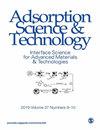Zeolite Application in Wastewater Treatment
IF 2.8
4区 工程技术
Q2 CHEMISTRY, APPLIED
引用次数: 41
Abstract
As a scarce natural resource, the preservation of water quality is of fundamental importance to guarantee its availability for future generations. Due to the increasing industrial activity, effluents are generated with a series of chemical compounds, such as nitrogenous, phosphoric, and organic compounds, heavy metals, and dyes which, if improperly disposed of, contribute to contamination, followed by significant environmental impacts, in addition to the damage to human health. The adsorption technique is an effective approach for removing contaminants from effluents, showing high versatility, due to the use of various materials as adsorbents. Belonging to a wide variety of materials, zeolites reveal to be a promising adsorbent. Zeolites are minerals found in nature or which can be synthesized from industrial residues, standing out in the treatment of contaminated effluents. Zeolite removal efficiency depends on the contaminant to be removed and can reach up to 96% for heavy metals, 90% for phosphoric compounds, 96% for dyes, 80% for nitrogen compounds, and 89% for organics. Aiming at the identification of the more relevant findings and research gaps to advance the use of zeolites in the large-scale treatment of industrial effluents, a review on the recent application of zeolites is needed. This paper presents a global view of zeolites, and a review is conducted on several recent studies using zeolites as adsorbents for the contaminants considered, indicating the main characteristics of the various adsorption systems, demonstrating the particularities of each process, and aiming to reveal useful information to provide future research, in addition to identifying points that need further investigation.沸石在废水处理中的应用
作为一种稀缺的自然资源,保护水质对保证子孙后代的可得性至关重要。由于工业活动的增加,废水中产生了一系列化合物,如含氮、磷和有机化合物、重金属和染料,如果处理不当,除了对人类健康造成损害外,还会造成严重的环境影响。吸附技术是一种有效的去除废水中污染物的方法,由于它可以使用多种材料作为吸附剂,因此具有很高的通用性。沸石属于种类繁多的材料,是一种很有前途的吸附剂。沸石是自然界中发现的矿物,也可以从工业残留物中合成,在污染废水的处理中脱颖而出。沸石的去除效率取决于要去除的污染物,对重金属的去除效率可达96%,对磷化合物的去除效率可达90%,对染料的去除效率可达96%,对氮化合物的去除效率可达80%,对有机物的去除效率可达89%。为了找出更相关的发现和研究空白,以推进沸石在工业废水大规模处理中的应用,有必要对沸石的最新应用进行综述。本文介绍了沸石的整体观点,并对最近几项使用沸石作为所考虑污染物吸附剂的研究进行了综述,指出了各种吸附系统的主要特征,展示了每个过程的特殊性,旨在揭示有用的信息,为未来的研究提供有用的信息,并确定需要进一步研究的点。
本文章由计算机程序翻译,如有差异,请以英文原文为准。
求助全文
约1分钟内获得全文
求助全文
来源期刊

Adsorption Science & Technology
工程技术-工程:化工
CiteScore
5.00
自引率
10.30%
发文量
181
审稿时长
4.5 months
期刊介绍:
Adsorption Science & Technology is a peer-reviewed, open access journal devoted to studies of adsorption and desorption phenomena, which publishes original research papers and critical review articles, with occasional special issues relating to particular topics and symposia.
 求助内容:
求助内容: 应助结果提醒方式:
应助结果提醒方式:


